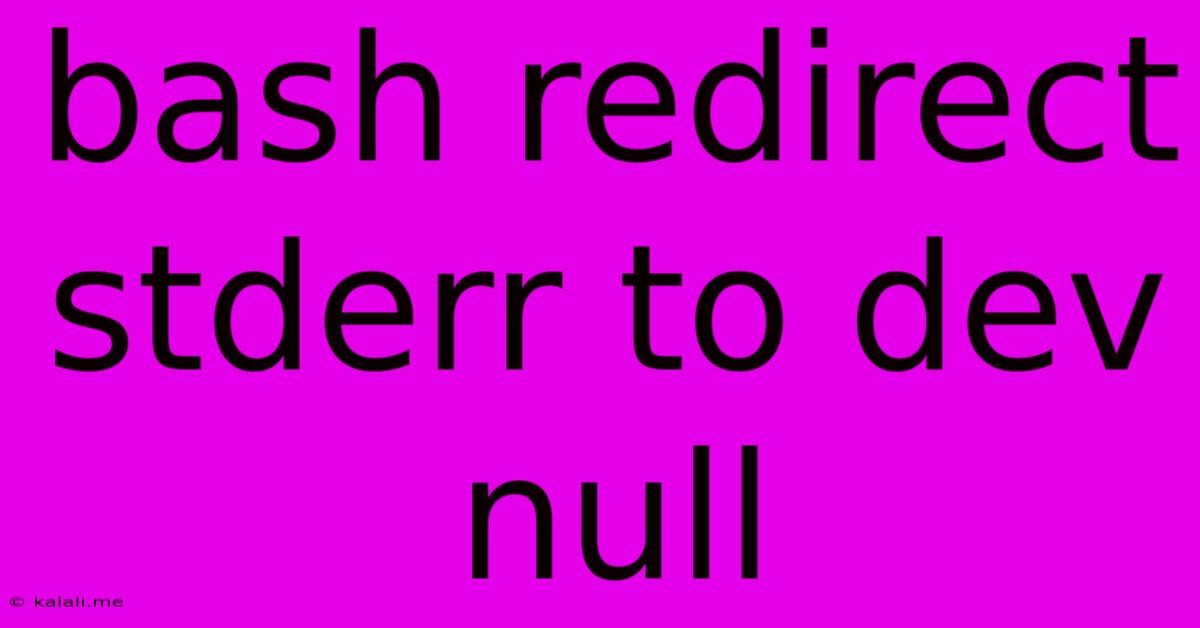Bash Redirect Stderr To Dev Null
Kalali
Jun 02, 2025 · 3 min read

Table of Contents
Silencing the Errors: Redirecting stderr to /dev/null in Bash
Ever run a bash script and been bombarded with error messages cluttering your terminal? This article explains how to efficiently manage and suppress these error messages using the /dev/null device. Understanding how to redirect standard error (stderr) is a crucial skill for any serious bash scripter, improving both script readability and maintainability. We'll cover the basics, explore different approaches, and discuss when this technique is particularly useful.
What is /dev/null?
/dev/null is a special file in Unix-like operating systems, often called the "bit bucket" or "black hole". Anything written to /dev/null is effectively discarded; it's a convenient way to ignore unwanted output. This is particularly useful for suppressing error messages from commands within your bash scripts.
Redirecting stderr: The Basics
Standard error (stderr) is a separate output stream from standard output (stdout). While stdout typically displays the program's regular output, stderr displays error messages and warnings. To redirect stderr to /dev/null, we use the 2> redirection operator.
The basic syntax is:
command 2> /dev/null
This command redirects only the standard error output of command to /dev/null. Any standard output (e.g., successful results) will still appear on the terminal.
Examples
Let's say you have a command that might produce errors:
grep "nonexistent pattern" myfile.txt
This command will likely produce an error if "nonexistent pattern" isn't found in myfile.txt. To silence this error message:
grep "nonexistent pattern" myfile.txt 2> /dev/null
Now, the error message will be discarded, and only successful matches (if any) will be printed to the terminal. This is cleaner and more manageable, especially within larger scripts.
Redirecting both stdout and stderr
Sometimes you might want to suppress both stdout and stderr. You can achieve this using the following:
command > /dev/null 2>&1
This redirects stdout to /dev/null (>), then redirects stderr (file descriptor 2) to the same location as stdout (file descriptor 1) using 2>&1. This ensures both streams are silenced.
Combining with Background Processes
If you're running commands in the background using &, you can still redirect stderr:
long_running_command 2> /dev/null &
This runs long_running_command in the background and silences any error messages it generates.
When to Use /dev/null Redirection
- Suppressing Unimportant Errors: If error messages are expected but not crucial to the script's execution, redirecting to
/dev/nullkeeps the output clean. - Log File Management: Instead of silencing entirely, consider redirecting error messages to a dedicated log file for debugging purposes.
- Improving Script Readability: Cleaning up the terminal output makes scripts easier to understand and troubleshoot.
- Automated Processes: In automated scripts or cron jobs, suppressing non-critical error messages prevents unnecessary email alerts or terminal clutter.
Caution: While redirecting stderr to /dev/null is often convenient, remember that you're losing potential debugging information. Use this technique judiciously. Only suppress errors you understand and are confident are not indicative of a serious problem. For critical applications, proper logging and error handling are preferable. Using /dev/null should be a deliberate choice, not a default behavior for all commands.
By mastering stderr redirection, you can create cleaner, more efficient, and ultimately more robust bash scripts. Remember to choose the approach that best suits your specific needs and always prioritize proper error handling and logging when dealing with critical applications.
Latest Posts
Latest Posts
-
Who Can I Pay To Make A Game
Jun 04, 2025
-
How Much Prime Rib Roast Beef Per Person
Jun 04, 2025
-
Fallout 4 How To Connect Power To Lights
Jun 04, 2025
-
Star Of David With A Cross
Jun 04, 2025
-
Colors Of Ingredients Needed For Alchemical Gold
Jun 04, 2025
Related Post
Thank you for visiting our website which covers about Bash Redirect Stderr To Dev Null . We hope the information provided has been useful to you. Feel free to contact us if you have any questions or need further assistance. See you next time and don't miss to bookmark.